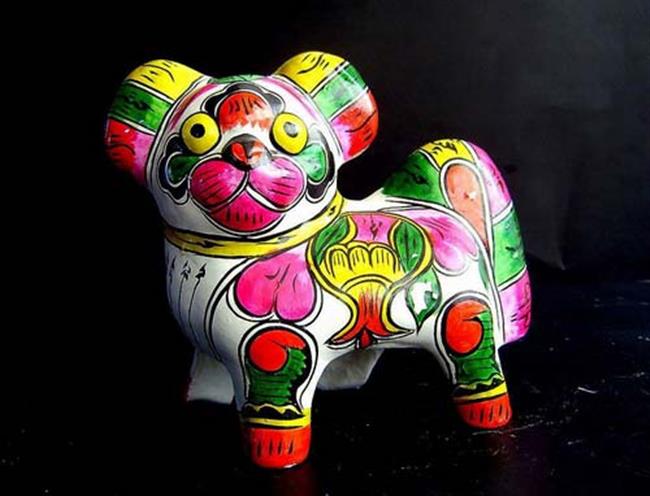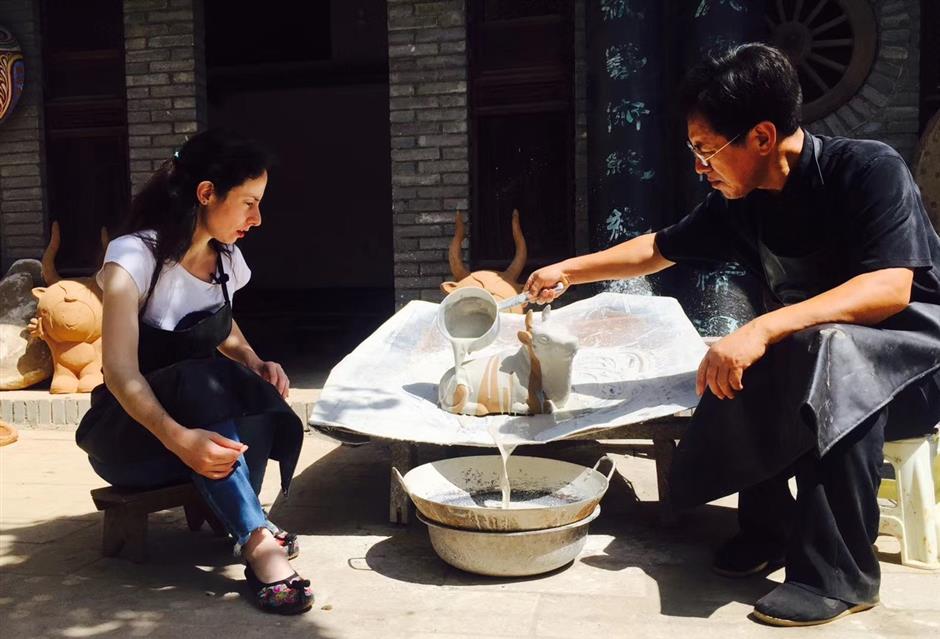A French connection to traditional Chinese culture and life

Berenice Zandonai (right) visits Zhang Ximin, a 10-generation Huayin Laoqiang artist.
The 24 solar terms, based on the sun’s position, were created by ancient Chinese people to guide their seasonal agricultural activities such as planting and harvesting.
They reflect the more nuanced changes in climate, natural phenomena, agricultural cycles and other aspects of life than the simple divisions of the year into spring, summer, autumn and winter.
And the solar terms have for hundreds of years greatly influenced people’s daily lives and even now continue to play an important role.
Berenice Zandonai, a French designer living in Xi’an, capital of northwestern China’s Shaanxi Province, has recently published a bilingual picture book “Fairy Tales of 24 Solar Terms,” illustrated by Xi’an artist Qiao Qiao.
The book in French and Chinese aims to “let the world know about and understand China’s amazing 24 solar terms.”

The bilingual picture book “Fairy Tales of 24 Solar Terms”
Zandonai first came to China in 2002 when she was a high school student. During the three-week summer tour, she visited many cities including Beijing, Qingdao, Xi’an, Luoyang, Nanjing, Shanghai, Hangzhou and Suzhou. She gained a deep understanding of traditional culture, such as calligraphy, kung fu, tai chi, Peking Opera, acrobatics, food and language.
Zandonai fell immediately in love with China, starting to study Chinese by herself and trying to sing Chinese songs after she went back to France. She also drew a lot of paintings on Chinese subjects. In 2006, having graduated from a university in Toulouse, she entered Nanjing Normal University to further her study in Chinese.
At the end of 2007, Zandonai came to Shanghai to work as a senior designer in a French fashion design and trading company. She lived for seven years here, building up her Chinese by speaking daily with her friends, neighbors and colleagues.
“To be honest, I love Shanghai very much, and it was a bit of a pity to leave,” she says via an e-mail interview with Shanghai Daily. “I hope that one day I can come back.”
At the end of 2014, Zandonia moved to Xi’an. “My husband is Chinese, from Xi’an,” she says. “He wants to be back in his hometown because he sees better working opportunities there.
“Now, the Chinese government is implementing the Belt and Road Initiative which is attracting more and more people from around the world to the ancient capital to live and to work.”
Zandonia has set up a small design and creative studio in Xi’an, working with local artists. One recent project was to create two WeChat emojis — Fengxiang clay figurine and Huayin Laoqiang (Old Tune) Opera.
The Fengxiang clay figurines are a traditional folk handicraft produced in Shaanxi’s Fengxiang County. Featuring distinctive designs and bright colors, they have been gaining increasing popularity among people in and outside China in recent years.

Fengxiang clay figurine
As for Huayin Laoqiang, Zandonia recalls watching a “wonderful performance” during the 2016 Spring Festival Gala Show: “I was really attracted to their voice and performing style.”
Every region in China has its own style of music. In Shaanxi, the area around Huashan Mountain gave birth to Huayin Laoqiang, a traditional form of art that features rousing, rhythmic and lusty folk singing and narration. Dubbed “ancient Chinese rock ’n’ roll,” it was listed as a national intangible cultural heritage by the Ministry of Culture.
“I want more and more people, Chinese and foreign, to know about these wonderful folkloric cultures,” she says.
“The WeChat emojis platform is now becoming more international. A lot of my friends living in France and in some other countries use WeChat. I hope that they could use the cute emojis and better understand Chinese culture.”
In 2006, Fengxiang clay figurines was listed as a National Intangible Cultural Heritage. In Liuying Village, there are now 2,000 people involved in the clay figurine industry. Craftsmen have improved their traditional techniques and made the figures stronger. More designs have been developed as well.
Q: How did you come across Fengxiang clay figure and Huayin Laoqiang?
A: When we just arrived in Xi’an at the end of 2014, one of my husband’s best friends offered me a small Fengxiang clay figure, a tiger head-shaped accessory, and told me that this was the folkloric culture originating from Fengxiang Village. I love it very much because of the rich colors and lovely appearance.
Since then, I dreamed one day to visit Fengxiang Village and find out how people there could make so lovely products.
About Huayin Laoqiang, I found it when I watched the program called “Chinese Bridge” on CCTV. Some foreigners went to Huayin Village to experience this ancient opera. When I got an opportunity, I too went there to learn from Master Zhang Ximin, a 10th-generation Laoqiang artist.

Berenice Zandonai learns how to make clay figurine from a master in FEngxiang County.
Q: What’s your understanding of traditional Chinese culture?
A: I love Chinese culture. China is a big country with a long history. There are so many wonderful and amazing regional cultures to discover, to experience and to study. As a foreigner who can speak Chinese, I feel very lucky and also proud of myself. I will spend more time in China trying to discover more traditional cultures.
Q: What do you think can be done for Chinese culture to be enjoyed by more people outside China?
A: In order to let the world better understand China and Chinese traditions, the country and its people should do more cultural exchanges. For example, translating the traditional culture into different languages, and inviting foreigners to visit, travel and work here.
What I can do is to present China and Chinese culture to the outside world based on my experiences, and also help the Chinese to better understand the world.
Q: What will be your next project?
A: Now with Qiao Qiao, we are working on another bilingual picture book on traditional festivals. We want to have it published by the end of this year.
I’m now also working with a Chinese filmmaking company to help translate their new film “Crested Ibis” into French. We are working together to introduce this environmental protection film to the French-speaking world.

Huayin Laoqiang is a traditional form of art that features rousing and lusty folk singing and narration.
















